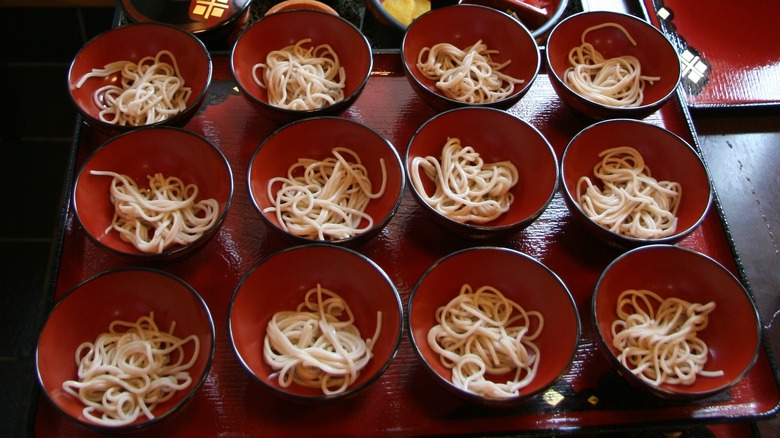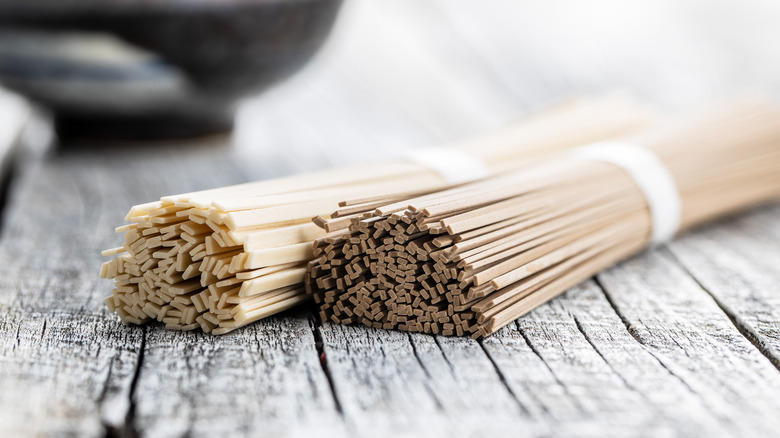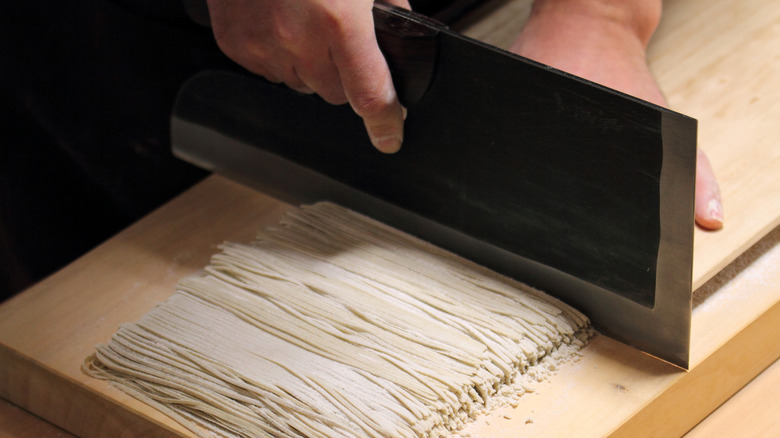Japan's Wanko Soba Is A Joyful All-You-Can-Eat Noodle Experience
So, there's a place in Japan where servers yell and stack up towers of colorful little bowls on your table. Intrigued? Feel free to be curious, because it's one of the most unique — and fun — dining experiences you could have when visiting Japan. Japanese people are generally thought of as polite and cultured with a strong sense of hospitality. According to Maikoya, the Toyko Good Manners Project was founded to ensure that these customs continue into future generations. So the idea of servers shouting to get customers to gobble up more food might go against your image of Japanese restaurants, but you can experience this type of playfully pushy environment for yourself in Iwate prefecture.
Iwate lies within the northern Honshu region of Japan, about two hours from Toyko via bullet train, according to Visit Iwate. The area offers many reasons to take that journey, but none more compelling than a dining experience called wanko soba. For fun-loving eaters or noodle-obsessed slurpers, it's almost a Japanese travel requirement. Though wanko soba is a regional specialty dish, it's more about how the noodles are consumed than the food itself.
Keep those noodles coming
The saying goes, life isn't about the destination but the journey. In the case of wanko soba, that culinary journey starts with a single small, brightly hued bowl, usually red, which is a beloved Japanese color often associated with festivals and fun, notes Japan Travel. Soba is a type of noodle, but the wanko part involves the customary way of eating it. That first bowl you receive is small because you're expected to eat a whole lot of noodles, each serving arriving in an identical bowl that never leaves your table.
Here's how the experience unfolds, as explained by CNN. Your first bowl of steaming wanko soba arrives, consisting of rustic buckwheat soba noodles served in a "wanko," meaning bowl. There's a smattering of side dishes, which are better left untouched until you complete the wanko soba challenge. Specifically, that means you're competing against diners past and present to see who polishes off the highest amount of soba, measured by the endless bowls rising in a stacked tower atop your table.
The bowls are never taken away and there's no need to request more — a new bowl instantly shows up the minute you empty the current one. And don't even think about refusing without a sufficiently accumulated stack. As for how much is enough, the record at Azumaya Soba Shop in Morioka, the capital city of Iwate, is 570 bowls, per CNN. For perspective, about 15 small wanko soba bowls equal a standard-size bowl of noodles.
Hai dandan!
And then there's the yelling or urgent but gentle encouragement, depending on the server. To keep your appetite animated and competitive nature intact, the wanko soba servers goad you on with an animated, "Hai dandan!" which roughly translates to "Eat more! More!" according to CNN. The phrase dandan, translated by JLPT Sensei, refers to gradually increasing, little by little, and then more and more. The playful shout can also come in the form of "Hai, jan-jan! Don-don!" per The Takeout.
The noodles come swimming in a broth (but serious wanko sabo competitors avoid filling up on liquids) alongside condiments and side dishes, known as yakumi, which vary by season and restaurant, but typically include staples such as tuna sashimi, wasabi, sesame pastes, mushrooms, grated taro, local pickles, and local seaweed varieties, per The Takeout.
So now you know about the don't-miss gastro adventure when visiting Japan. Buy why board an airplane? You could throw convention to the wind and host an all-you-can-eat wanko soba night in your own home. Be sure to invite fun folks and tell them to bring a big appetite.


